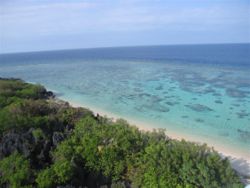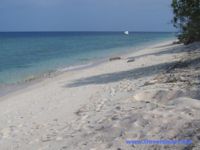Asia/Philippines/Occidental Mindoro/Sablayan/Apo Reef/: Difference between revisions
No edit summary |
No edit summary |
||
| Line 6: | Line 6: | ||
Apo Reef is a series of coral reefs encompassing 34 square kilometers within the waters of Occidental Mindoro in the Philippines. It is the world's second-largest contiguous coral reef system and the largest in the country.[1] The reef and its surrounding waters are administered as a National Park as part of the Apo Reef Natural Park project.<ref name=wikipedia>[http://en.wikipedia.org/wiki/Apo_Reef Apo Reef] Wikipedia.ORG. Accessed November 2007.</ref> | Apo Reef is a series of coral reefs encompassing 34 square kilometers within the waters of Occidental Mindoro in the Philippines. It is the world's second-largest contiguous coral reef system and the largest in the country.[1] The reef and its surrounding waters are administered as a National Park as part of the Apo Reef Natural Park project.<ref name=wikipedia>[http://en.wikipedia.org/wiki/Apo_Reef Apo Reef] Wikipedia.ORG. Accessed November 2007.</ref> | ||
Apo Reef can be found around 33 kilometers west off of the mid-western coast of the Philippine island of Mindoro. Two separate coral reefs make up the atoll-reef system. The two reefs are separated by a 30 meter-deep channel between them.[1] Several environments can be found within the reef's boundaries. Aside from coral reefs, seagrass meadows, beds of macroalgae and mangrove stands are present on and around the reef proper.<ref name= | Apo Reef can be found around 33 kilometers west off of the mid-western coast of the Philippine island of Mindoro. Two separate coral reefs make up the atoll-reef system. The two reefs are separated by a 30 meter-deep channel between them.[1] Several environments can be found within the reef's boundaries. Aside from coral reefs, seagrass meadows, beds of macroalgae and mangrove stands are present on and around the reef proper.<ref name="wikipedia"/> | ||
The waters of Apo Reef are protected within a National Park encompassing 27,469 hectares of the reef and its surrounding area. Of the total area, 15,792 hectares comprises the Apo Reef Natural Park while the remaining 11,677 hectares constitute a buffer zone surrounding the national park.<ref name= | The waters of Apo Reef are protected within a National Park encompassing 27,469 hectares of the reef and its surrounding area. Of the total area, 15,792 hectares comprises the Apo Reef Natural Park while the remaining 11,677 hectares constitute a buffer zone surrounding the national park.<ref name="wikipedia"/> | ||
Politically, the reef lies in waters within the jurisdiction of the province of Occidental Mindoro in region IV-B of the Philippines. It is directly administered by the local government of the municipality of Sablayan.<ref name= | Politically, the reef lies in waters within the jurisdiction of the province of Occidental Mindoro in region IV-B of the Philippines. It is directly administered by the local government of the municipality of Sablayan.<ref name="wikipedia"/> | ||
Originally, Apo Reef was first officially declared a | Originally, Apo Reef was first officially declared a "Marine Park" by then-Philippine president Ferdinand Marcos in 1980. This was followed up with the local government of Sablayan declaring the reef a special "Tourism Zone and Marine Reserve" three years later. In 1996, the entire reef was declared a protected natural park by then-president Fidel Ramos.<ref name="wikipedia"/> | ||
In 2006, the Protected Areas and Wildlife Bureau of the Philippine Department of Environment and Natural Resources submitted the reef to the UNESCO World Heritage Centre for consideration as a World Heritage Site.<ref name= | In 2006, the Protected Areas and Wildlife Bureau of the Philippine Department of Environment and Natural Resources submitted the reef to the UNESCO World Heritage Centre for consideration as a World Heritage Site.<ref name="wikipedia"/> | ||
Following a survey by the local chapter of the World Wide Fund for Nature, fishing within the reef was banned by the Philippine government in September 2007. The marine park would be opened for tourists to help generate funds for its protection as well as provide an alternative livelihood for hundreds of fishermen in the area.<ref name= | Following a survey by the local chapter of the World Wide Fund for Nature, fishing within the reef was banned by the Philippine government in September 2007. The marine park would be opened for tourists to help generate funds for its protection as well as provide an alternative livelihood for hundreds of fishermen in the area.<ref name="wikipedia"/> | ||
* Getting There | * Getting There | ||
| Line 37: | Line 37: | ||
== Gallery == | == Gallery == | ||
<gallery> | <gallery> | ||
Image:Tomacruz-2009-08-23-01-32-49.JPG| | |||
</gallery> | </gallery> | ||
Revision as of 01:33, 23 August 2009

Apo Reef

- Overview
Apo Reef is a series of coral reefs encompassing 34 square kilometers within the waters of Occidental Mindoro in the Philippines. It is the world's second-largest contiguous coral reef system and the largest in the country.[1] The reef and its surrounding waters are administered as a National Park as part of the Apo Reef Natural Park project.[1]
Apo Reef can be found around 33 kilometers west off of the mid-western coast of the Philippine island of Mindoro. Two separate coral reefs make up the atoll-reef system. The two reefs are separated by a 30 meter-deep channel between them.[1] Several environments can be found within the reef's boundaries. Aside from coral reefs, seagrass meadows, beds of macroalgae and mangrove stands are present on and around the reef proper.[2]
The waters of Apo Reef are protected within a National Park encompassing 27,469 hectares of the reef and its surrounding area. Of the total area, 15,792 hectares comprises the Apo Reef Natural Park while the remaining 11,677 hectares constitute a buffer zone surrounding the national park.[2]
Politically, the reef lies in waters within the jurisdiction of the province of Occidental Mindoro in region IV-B of the Philippines. It is directly administered by the local government of the municipality of Sablayan.[2]
Originally, Apo Reef was first officially declared a "Marine Park" by then-Philippine president Ferdinand Marcos in 1980. This was followed up with the local government of Sablayan declaring the reef a special "Tourism Zone and Marine Reserve" three years later. In 1996, the entire reef was declared a protected natural park by then-president Fidel Ramos.[2]
In 2006, the Protected Areas and Wildlife Bureau of the Philippine Department of Environment and Natural Resources submitted the reef to the UNESCO World Heritage Centre for consideration as a World Heritage Site.[2]
Following a survey by the local chapter of the World Wide Fund for Nature, fishing within the reef was banned by the Philippine government in September 2007. The marine park would be opened for tourists to help generate funds for its protection as well as provide an alternative livelihood for hundreds of fishermen in the area.[2]
- Getting There
Nearby Hotels & Resorts
- Asia/Philippines/Palawan/Coron/Club_Paradise/
- Pandan Island Resort
Related Links
Articles
- Diving The Far Side: Pandan Island & Apo Reef
- Top 10 Philippine thrills of the deep
- Dive sites in Mindoro and Cebu Dive sites in Mindoro and Cebu


